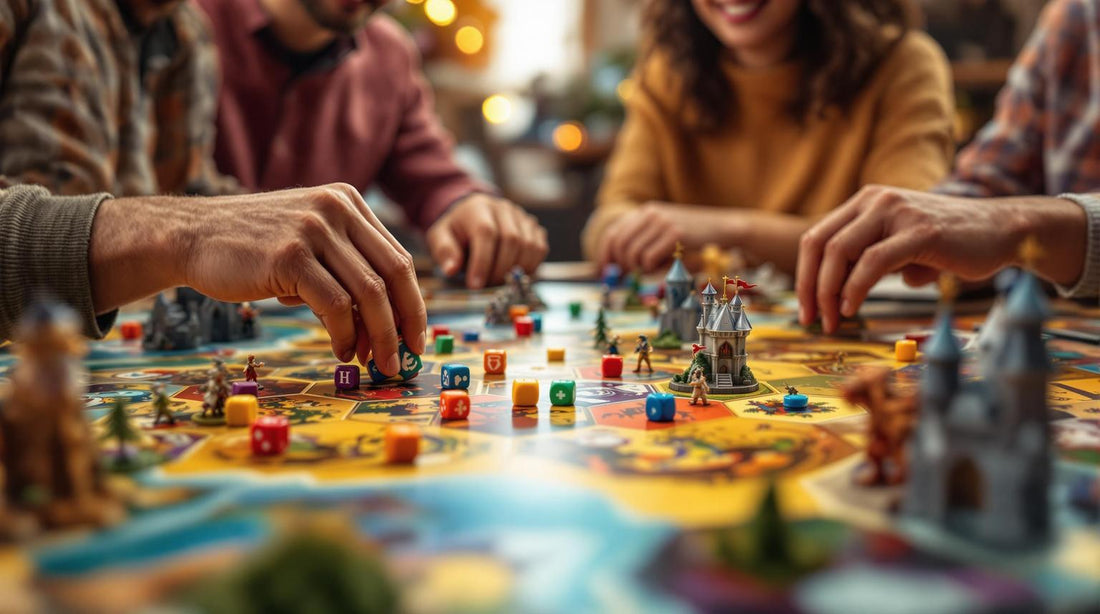Discover the Best Board Games for Every Player

Risk vs Reward: Balancing Strategies in Board Games
Winning board games often comes down to one key skill: balancing risk and reward. Whether you're playing aggressively to make a comeback or cautiously to protect a lead, understanding when to take risks and when to play it safe can make or break your strategy. Here's what you need to know:
- Risk: High-stakes moves, like bold attacks or resource investments, can lead to big rewards - but also setbacks.
- Reward: Smart risks can bring advantages like extra points, stronger positions, or unexpected gains.
- Balance: Overly cautious play may miss opportunities, while reckless moves can drain resources or expose weaknesses.
Quick Tips:
- Take risks when you're behind, breaking deadlocks, or spotting game-changing opportunities.
- Play it safe when you're leading, protecting key resources, or avoiding unnecessary losses.
- Learn game-specific strategies: e.g., diversify resources in Catan, manage armies in Risk, or prioritize cures in Pandemic.
| Game | Risk Elements | Reward Potential | Strategy |
|---|---|---|---|
| Catan | Resource trading, settlement placement | Resource monopolies, bonuses | Focus on high-probability numbers but avoid overexposure. |
| Risk | Aggressive attacks, territorial spread | Rapid expansion | Balance bold attacks with protecting your armies. |
| Pandemic | Tackling outbreaks vs long-term cures | Preventing outbreaks, curing diseases | Coordinate with teammates to manage threats. |
Mastering risk-reward balance sharpens your decision-making and gives you an edge in any game. Ready to level up your strategy? Dive into the details below.
RISK Strategy Guide - Top 10 Tips
When to Take Risks: Key Game Moments
Strategically taking risks at the right moments can completely change the direction of a board game. Some situations call for bold, calculated moves that go beyond standard strategies. These critical moments require sharp decision-making that can set you apart from your competition.
Making a Comeback
If you're falling behind, playing it safe often won't cut it. This is the time to take bold actions that could turn the tide in your favor. Opt for high-risk, high-reward moves to shake things up and potentially close the gap with the leaders.
Spotting the Right Opportunities
Timing matters. In games like Pikoko, going for aggressive bets - even when the odds don’t seem to favor you - can lead to surprising victories. These opportunities often arise when your opponents are distracted, resources shift dramatically, or the game's dynamics change. Spotting these shifts lets you capitalize on the risk-reward mechanics effectively.
Breaking Deadlocks
When the game grinds to a halt and standard strategies fail to make progress, taking a risk might be your best option. This means evaluating the current state of play, predicting potential chain reactions, and, if it's a team game, coordinating with your allies to break the stalemate. This kind of bold move can reignite momentum and push the game forward.
When to Play Safe: Keeping Your Edge
After looking at the moments to take bold risks, let’s shift focus to when cautious gameplay is the smarter choice. Sometimes, playing it safe is the key to maintaining your advantage and ensuring long-term success.
Taking calculated risks can lead to big rewards, but playing conservatively helps you protect your lead and avoid unnecessary losses.
Keeping the Lead
If you're in the lead, your priority should be steady, low-risk moves that keep building your points. The exact defensive approach depends on the game:
| Game | Safe Strategy | Expected Outcome |
|---|---|---|
| Splendor | Focus on tier-1 cards and noble tiles | Consistent point growth |
| Catan | Diversify resource collection | Minimized vulnerabilities |
| Ticket to Ride | Complete short routes first | Early and secure points |
Avoiding Bad Risks
In games like Carcassonne, putting too many resources into one area can leave you exposed. Before taking a risk, think about:
- How it aligns with your main strategy
- Factors you can’t control
- The likelihood of opponents interfering
- Whether the reward outweighs your current position
Protecting Key Resources
In deck-building games such as Dominion, safeguarding your most valuable cards is critical. Here are some ways to protect your assets:
- Keep your deck balanced rather than relying on a single powerful combo.
- Always have defensive options available.
- Build backup strategies to handle unexpected setbacks.
- Add buffers to secure your critical resources.
Playing it safe doesn’t mean being passive - it’s about making thoughtful decisions that protect your position. These approaches ensure your defensive moves work hand-in-hand with your overall strategy.
sbb-itb-1ed942f
Risk-Reward Systems in Popular Games
Risk and reward are at the heart of many popular games, shaping strategies and influencing decisions. By understanding how these mechanics work, players can improve their gameplay and identify the right moments to take calculated risks.
Game Mechanics Comparison
Here’s a look at how three well-known games incorporate risk-reward elements:
| Game | Risk Elements | Reward Potential | Strategic Considerations |
|---|---|---|---|
| Catan | Trading resources and settlement placement | Gaining resource monopolies and earning bonuses | Focusing on high-probability numbers (like 6 or 8) can lead to steady gains but may invite competition or robber attacks. |
| Risk | Dice-based combat and territorial expansion | Expanding territories and securing positions | Aggressive moves can lead to rapid growth but may leave armies vulnerable to counterattacks. |
| Pandemic | Managing urgent threats and long-term cures | Preventing outbreaks and curing diseases | Players must weigh treating immediate outbreaks against preparing for cures, as delays can worsen the crisis. |
Each game’s mechanics require a unique approach to managing risk and reward.
In Risk, players must navigate territorial battles, balancing aggressive moves with the need to protect their armies. A bold attack can lead to rapid expansion, but overextending can leave you exposed to retaliation.
In Pandemic, the challenge shifts to cooperative risk management. Players work together to tackle immediate outbreaks while planning long-term cures. Mismanaging priorities can quickly escalate the situation, making teamwork essential.
These examples highlight how different games force players to weigh short-term risks against long-term rewards, sharpening their strategic thinking.
For those wanting more insight into these systems, Brain Games offers strategy guides with many of their games. These guides break down the nuances of risk management, making it easier for players of all skill levels to master the mechanics.
How to Balance Risk and Reward
Balancing risk and reward involves making informed decisions by evaluating odds, understanding your opponents, and adjusting strategies when needed. Here's how to approach it effectively.
Calculating Odds and Results
When deciding on risky moves, it's essential to assess probabilities and outcomes clearly. Use the following methods to guide your decisions:
| Assessment Factor | How to Calculate | Example |
|---|---|---|
| Success Probability | Divide favorable outcomes by total possible outcomes | Rolling 5+ in Risk: 2/6 = 33.3% |
| Potential Gain | Multiply resources/points gained by success probability | Gaining 3 armies: 3 × 33.3% |
| Potential Loss | Multiply resources/points lost by failure probability | Losing 2 armies: 2 × 66.7% |
| Position Impact | Rate impact on a scale of -5 to +5 | Gaining Australia in Risk: +4 |
In dice games like Risk, you can calculate success rates precisely. For card games, tracking played cards can help you estimate the odds of specific draws. Once you've quantified the risks, consider how opponents might react to fine-tune your strategy.
Understanding Opponent Moves
Anticipating your opponents' strategies is just as important as calculating probabilities. Watch for these behavioral patterns:
| Pattern Type | What to Observe | How to Respond |
|---|---|---|
| Resource Management | How they prioritize resources | Target resources they need most |
| Risk Tolerance | Frequency of aggressive vs. cautious moves | Exploit overly bold or conservative tendencies |
| Board Position | Areas where they focus their forces | Identify and exploit weakly defended areas |
Keep in mind that players may adjust their behavior based on their position in the game. Someone falling behind might take bigger risks, while a leader could play more cautiously. Stay alert to these shifts and adapt your moves accordingly.
Changing Plans Mid-Game
Being flexible is key to maintaining a good balance between risk and reward. Your initial strategy might need to change as the game evolves. Pay attention to:
- Game State Changes: When contested territories or resources shift the balance of power.
- Opponent Actions: If multiple players begin targeting your position.
- Resource Availability: When critical resources become scarce.
Act quickly when the odds of success change dramatically.
Here are some signs that it’s time to adjust your strategy:
| Indicator | What to Watch For | What to Do |
|---|---|---|
| Resource Depletion | Fewer than 3 turns of sustainability | Shift to conserving resources |
| Position Weakness | Multiple exposed fronts | Consolidate forces in stronger positions |
| Opportunity Cost | Better options arise | Redirect resources to higher-value targets |
Winning often depends on recognizing when to pivot. Keep an eye on the game state, and don’t hesitate to change course - even if it means abandoning earlier investments. This ability to adapt is what sets seasoned players apart from newcomers.
Conclusion: Finding Your Risk Balance
Mastering the balance between risk and reward in board games requires sharp strategy and thoughtful decision-making. There’s no universal formula - each situation calls for its own approach. The key is to carefully evaluate each choice by weighing immediate benefits against potential long-term consequences.
Consider these factors when adjusting your risk tolerance:
- Game Phase: Early moves often carry less weight than critical endgame decisions.
- Board Position: Your standing in the game determines which risks are worth taking.
- Resources: The resources you have on hand affect how well you can recover from setbacks.
These elements help shape your strategy throughout the game. Start by practicing with low-stakes decisions, like simple probability calculations in dice games, before tackling more complex strategies in games that involve resource management.
Interestingly, these skills aren’t just for gaming - they echo real-world decision-making. Managing risk in board games teaches you how to assess probabilities, evaluate positions, and plan ahead. The goal is to develop a balanced strategy that fits your style while staying flexible enough to adapt to changing circumstances.
Want to improve? Watch how seasoned players handle risk. Across all stages of the game, aligning risk with reward is the foundation of strategic success.






